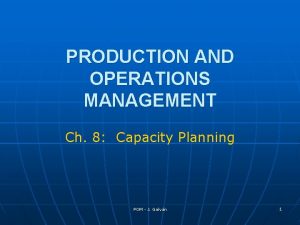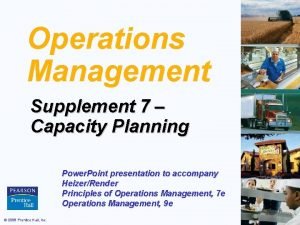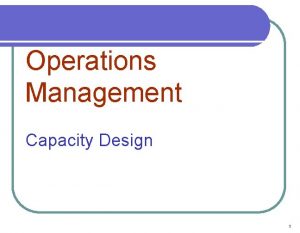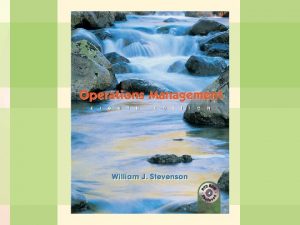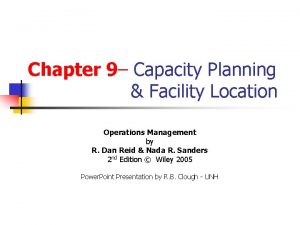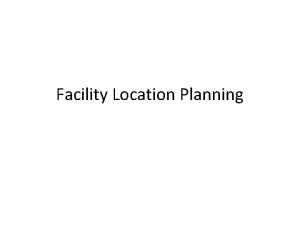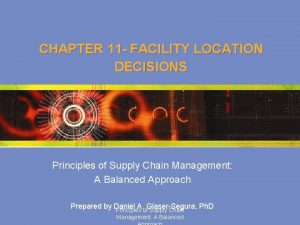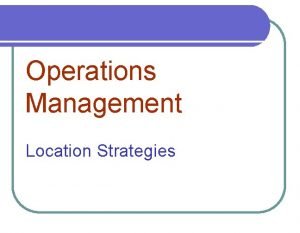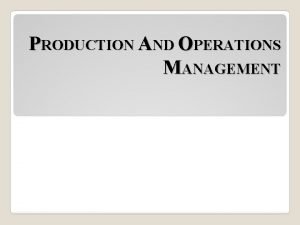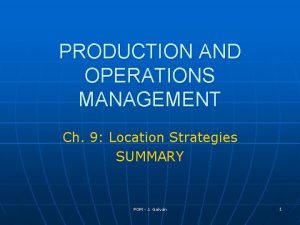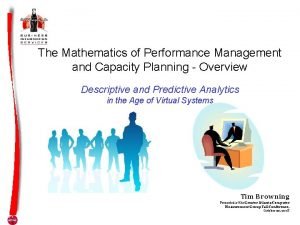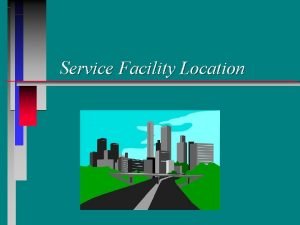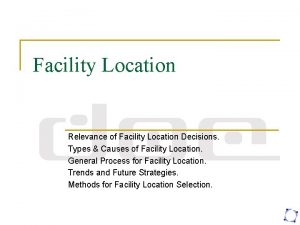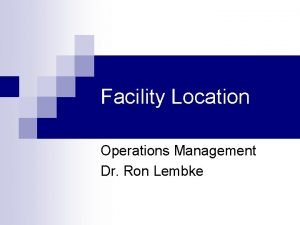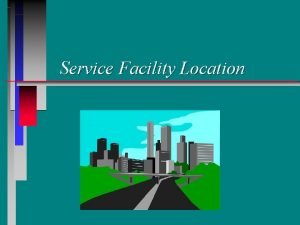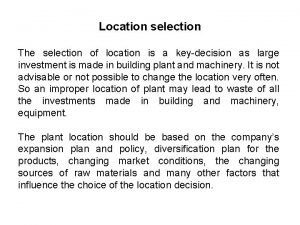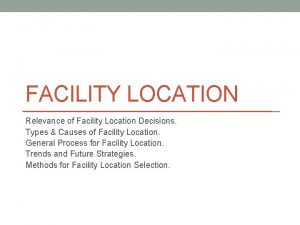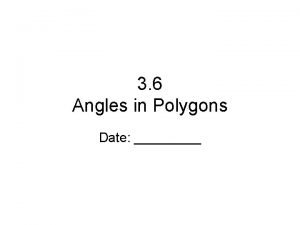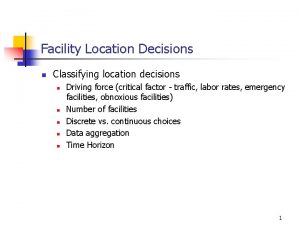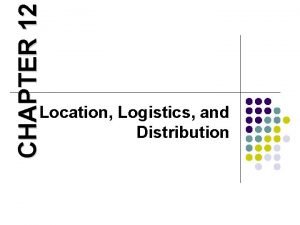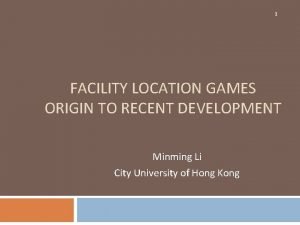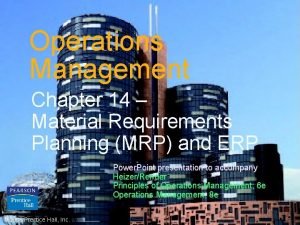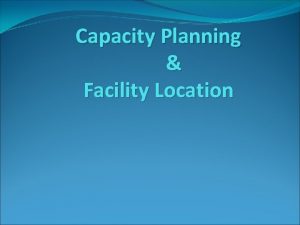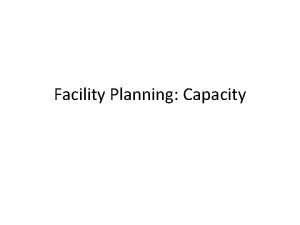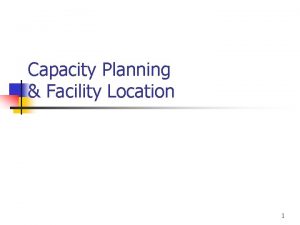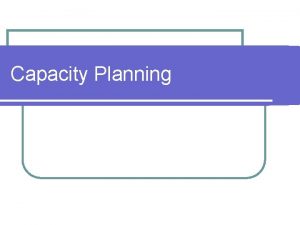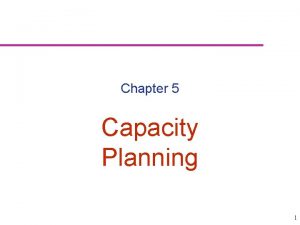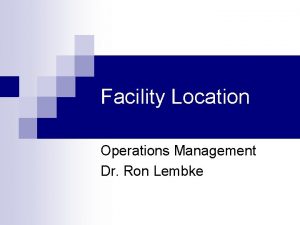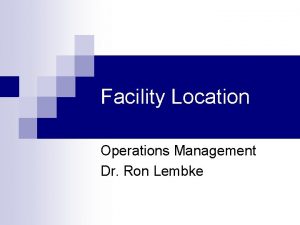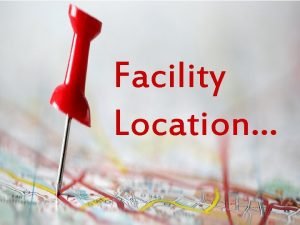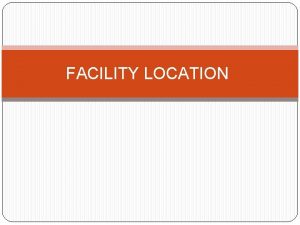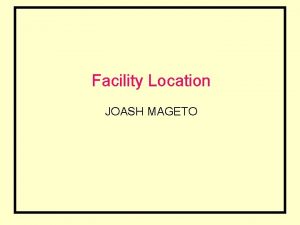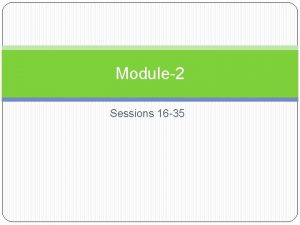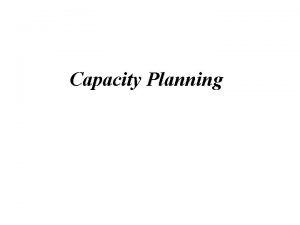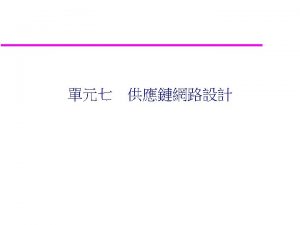Chapter 9 Capacity Planning Facility Location Operations Management




























- Slides: 28

Chapter 9– Capacity Planning & Facility Location Operations Management by R. Dan Reid & Nada R. Sanders 2 nd Edition © Wiley 2005 Power. Point Presentation by R. B. Clough - UNH

Capacity planning n n Capacity is the maximum output rate of a production or service facility Capacity planning is the process of establishing the output rate that may be needed at a facility: n Capacity is usually purchased in “chunks” n Strategic issues: how much and when to spend capital for additional facility & equipment n Tactical issues: workforce & inventory levels, & day-to-day use of equipment

Measuring Capacity Examples n n n There is no one best way to measure capacity Output measures like kegs per day are easier to understand With multiple products, inputs measures work better

Capacity Information Needed n Design capacity: n n n Maximum output rate under ideal conditions A bakery can make 30 custom cakes per day when pushed at holiday time Effective capacity: n n Maximum output rate under normal (realistic) conditions On the average this bakery can make 20 custom cakes per day

Calculating Capacity Utilization n Measures how much of the available capacity is actually being used: n n Measures effectiveness Use either effective or design capacity in denominator

Example of Computing Capacity Utilization: In the bakery example the design capacity is 30 custom cakes per day. Currently the bakery is producing 28 cakes per day. What is the bakery’s capacity utilization relative to both design and effective capacity? n n The current utilization is only slightly below its design capacity and considerably above its effective capacity The bakery can only operate at this level for a short period of time

How Much Capacity Is Best? n n The Best Operating Level is the output that results in the lowest average unit cost Economies of Scale: n n n Where the cost per unit of output drops as volume of output increases Spread the fixed costs of buildings & equipment over multiple units, allow bulk purchasing & handling of material Diseconomies of Scale: n n Where the cost per unit rises as volume increases Often caused by congestion (overwhelming the process with too much work-in-process) and scheduling complexity

Economies and Diseconomies of Scale

Adding Capacity in “Chunks”

Other Capacity Considerations n Focused factories: n n Plant within a plant (PWP): n n Segmenting larger operations into smaller operating units with focused objectives Subcontractor networks: n n Small, specialized facilities with limited objectives Outsource non-core items to free up capacity for what you do well Capacity cushions: n Plan to underutilize capacity to provide flexibility

Designing Assembly Lines n n n Step 1: 2: 3: 4: Identify tasks & immediate predecessors Determine the desired output rate Calculate the cycle time Compute theoretical minimum number of workstations Step 5: Assign tasks to workstations (balance the line) Step 6: Compute efficiency, idle time & balance delay

Example: Vicki’s Pizzeria Assembly Line

Step 1: Draw the Precedence Diagram

n Step 2: Determine output rate Vicki needs to produce 60 pizzas per hour Determine the Line’s Cycle Time n n Step 3: Determine cycle time The amount of time each workstation is allowed to complete its tasks

The Maximum Output The maximum output is limited by the bottleneck task (the longest task in a process):

Determine the Minimum Number of Stations n Step 4: Compute theoretical minimum number of stations n n n TM = number of stations needed to achieve 100% efficiency (every second is used) Always round up (no partial workstations) Serves as a lower bound for our analysis

Assign Tasks to Stations n Step 5: Assign tasks to workstations n n n Start at the first station & choose the longest eligible task following precedence relationships Continue adding the longest eligible task that fits without going over the desired cycle time When no additional tasks can be added within the desired cycle time, begin assigning tasks to the next workstation until finished

Calculate the Line’s Efficiency n Step 6: Compute efficiency and balance delay n n Efficiency (%) is the ratio of total productive time divided by total time Balance delay (%) is the amount by which the line falls short of 100%

Facility Location n Three most important factors in real estate: 1. 2. 3. n Location Facility location is the process of identifying the best geographic location for a service or production facility

Location Factors n Proximity to suppliers: n n Proximity to customers: n n Reduce transportation costs of perishable or bulky raw materials E. g. : high population areas, close to JIT partners Proximity to labor: n Local wage rates, attitude toward unions, availability of special skills (e. g. : silicon valley)

More Location Factors n Community considerations: n n Site considerations: n n Local zoning & taxes, access to utilities, etc. Quality-of-life issues: n n Local community’s attitude toward the facility (e. g. : prisons, utility plants, etc. ) Climate, cultural attractions, commuting time, etc. Other considerations: n Options for future expansion, local competition, etc.

Should Firm Go Global? n Potential advantages: n n Potential disadvantages: n n Inside track to foreign markets, avoid trade barriers, gain access to cheaper labor Political risks may increase, loss of control of proprietary technology, local infrastructure (roads & utilities) may be inadequate, high inflation Other issues: n Language barriers, different laws & regulations, different business cultures

Location Analysis Methods n Analysis should follow 3 step process: n n n n Step 1: Identify dominant location factors Step 2: Develop location alternatives Step 3: Evaluate locations alternatives Factor rating method Load-distance model Center of gravity approach Break-even analysis Transportation method

Factor Rating Example

A Load-Distance Model Example: Matrix Manufacturing is considering where to locate its warehouse in order to service its four Ohio stores located in Cleveland, Cincinnati, Columbus, Dayton. Two sites are being considered; Mansfield and Springfield, Ohio. Use the load-distance model to make the decision. n Calculate the rectilinear distance: n Multiply by the number of loads between each site and the four cities

Calculating the Load-Distance Score for Springfield vs. Mansfield n n The load-distance score for Mansfield is higher than for Springfield. The warehouse should be located in Springfield.

The Center of Gravity Approach n n n This approach requires that the analyst find the center of gravity of the geographic area being considered Computing the Center of Gravity for Matrix Manufacturing Is there another possible warehouse location closer to the C. G. that should be considered? ? Why?

Homework Ch. 10 Problems: 13, 15.
 Capacity in operations management
Capacity in operations management Capacity planning in operations management
Capacity planning in operations management Beprs
Beprs Location planning and analysis
Location planning and analysis Location planning management
Location planning management Load distance model
Load distance model Facility location planning
Facility location planning Location
Location Aggregate planning is capacity planning for
Aggregate planning is capacity planning for List the strategic objectives of aggregate planning
List the strategic objectives of aggregate planning Aggregate planning is capacity planning for
Aggregate planning is capacity planning for Objective of location strategy
Objective of location strategy Location strategy in operations management
Location strategy in operations management Location strategy in operations management
Location strategy in operations management Capacity and performance management
Capacity and performance management Chapter 12 inventory management
Chapter 12 inventory management Service facility location
Service facility location Centroid method of facility location
Centroid method of facility location Center of gravity method facility location example
Center of gravity method facility location example Three types of plant layout
Three types of plant layout Service facility location
Service facility location Facility location factors
Facility location factors Contoh layout perusahaan jasa
Contoh layout perusahaan jasa Facility location decisions are complex because
Facility location decisions are complex because Sum of exterior angles of a hexagon
Sum of exterior angles of a hexagon Location decisions
Location decisions Logistics system design matrix
Logistics system design matrix Facility location game
Facility location game Mrp 2 in operations management
Mrp 2 in operations management
